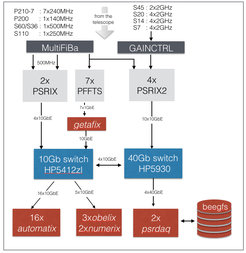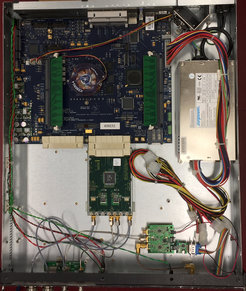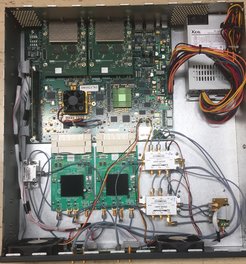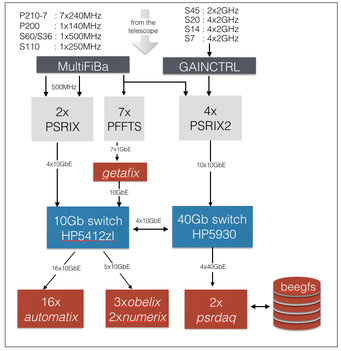Pulsar Instruments

The current generation of pulsar instruments at the Effelsberg 100-m were installed in three phases starting from 2009. The pulsar Fast Fourier transform spectrometer (PFFTS) was installed in 2009. The PFFTS is hardwired to the 7-beam receiver and has a fixed firmware that generates 512-channels over 300 MHz at 54 μs time resolution. The PFFTS was designed in-house within the signal processing department. The PSRIX system is based on the ROACH1 board developed by the CASPER consortium. This instrument was brought in to regular operations in 2011. The PSRIX2 instrument is based on ROACH2 platform (also developed by CASPER) and was put in to operation in 2017.

The ROACH1/ROACH2 were turned in to pulsar instruments with firmware developed in-house, additional network switches and a small cluster of high performance computers. A few firmware variants are in operation with which baseband, pulsar search or folded pulsar data can be generated. The PSRIX instrument is predominately used for longer wavelengths (eg, 21cm and 11cm) and therefore generates baseband as default, which originated from requirement of the LEAP effort. This design is also deployed both at the 76-m Lovell telescope at Jodrell Bank observatory, and at the 64-m Sardinia radio telescope. The PSRIX2 instrument implements only pulsar search mode outputs as the instrument is predominantly used for high frequency observations. A very similar design of the instrument is used for 3-mm pulsar observations at the IRAM 30-m telescope in Spain and was successfully tested at the 40-m Yebes radio telescope.

The baseband mode in PSRIX works up to a bandwidth of 500 MHz, with or without the option of subbands (implemented as polyphase filterbank in ROACH1/ROACH2 FPGAs). The large data rate (up to 32 Gbps, when two ROACH1 are used), necessitates the use of high performance switching gear (10 Gb and 40 Gb switches). The subbanded-data can be streamed to the small CPU cluster to coherently dedisperse and fold known pulsars or store the data to disk. Optionally, the full resolution baseband (up to 1ns) can be streamed to the GPU nodes to be coherently dedispersed or written to the high performance BeeGFS storage. The latter mode allows single pulse investigations up to 1 ns time resolution.
The search modes in PSRIX2 has two operational firmware variants. The first generates 2048 channels down to programmable integration of 8 μs and with a bandwidth of 2000 MHz. With four such ROACH2 units, up to 8 GHZ of bandwidth can be recorded. The firmware computes the four Stokes parameters prior to hardware integration of the intensities. This unit can also be reconfigured to process the output of two feeds of the Effelsberg 100-m telescope’s 7-beam receiver. Therefore the 4 ROACH2, with he right firmware, can be combined to process up to eight beams. In this mode a 512-channel firmware with a bandwidth of 500 MHz is used. The last mode is envisaged to replace the PFFTS in the long run.
Replacement for ROACH1 are also on plans, which are being coordinated with the receiver developments.


